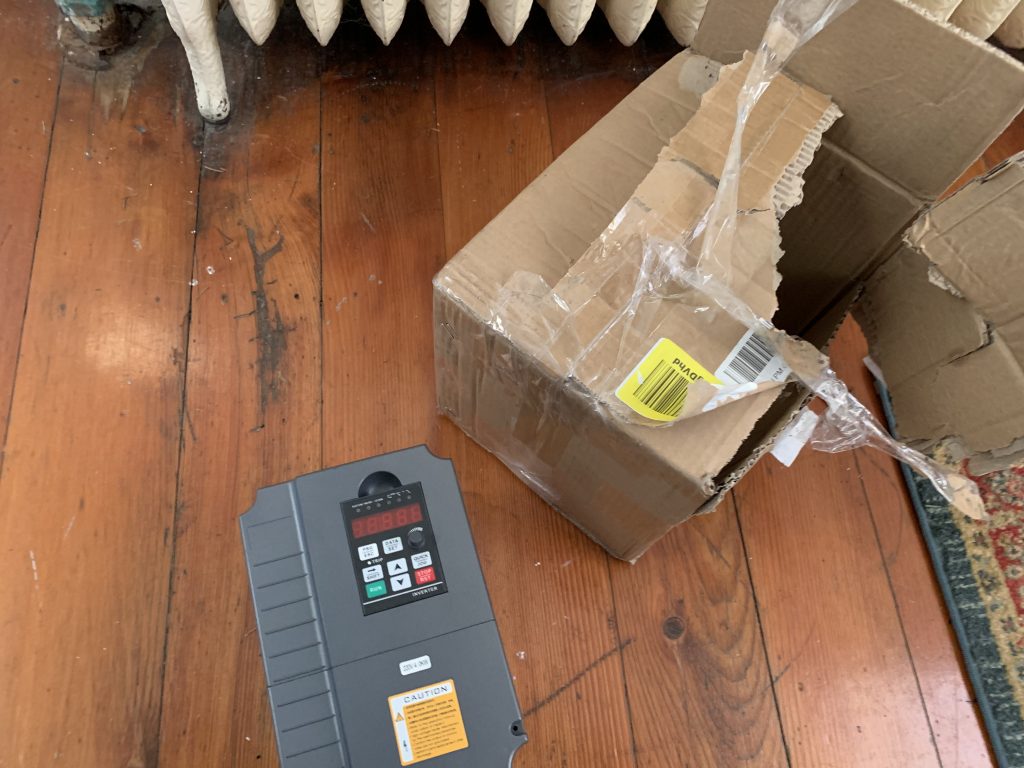We may receive a commission when you use our affiliate links. However, this does not impact our recommendations.
I am venturing into the world of VFDs for the first time and I think I’m nearly caught up to speed, but would love some input. If you’re not familiar with the term, it stands for variable-frequency drive and it allows you to run 3 phase equipment from a single phase power source. It’s a solution that many enthusiasts of old machinery have adopted to get industrial equipment running in their home shop.
The reason for my pursuit is that we are cycling the Powermatic 66 out of the Popular Woodworking shop and are bringing in a SawStop. Before I raise my hand to take the 66 home, I want to make sure I have a plan for the 5hp 3 phase motor it packs. I’ve found great information on the Old Woodworking Machine forums but there’s something just not sitting right about the whole situation.

My three-year-old son opened the box, I’m not an animal.

Many thumbs have used this manual before…
I’ve already received the VFD that was recommended by the forums in the mail but it came without any packaging and has clearly been used before (at the very least I’m returning for a new one.) Beyond the fact that it isn’t new, I am starting to worry about the fact that this piece of equipment is running a tremendous amount of power and isn’t UL listed in the U.S. Is this really how I want to lose my house? (Or am I being dramatic?)
I’ve put a call in to Powermatic to see what a realistic price would be for a 3hp 1phase motor but I didn’t have the serial number on hand when I called. From what I can tell online, I’m looking at about a $400 factory motor. Then, I’ll need to swap out the magnetic switch for the correct version, another $50.
I am aware that there are other options out there, static converters seem to be popular, but some people claim they are hard on the motor. Perhaps one of you have experience with this?
At this point, I’m really tempted to plunk down the cash for a new motor for the piece of mind. What would you do?
– David Lyell
Here are some supplies and tools we find essential in our everyday work around the shop. We may receive a commission from sales referred by our links; however, we have carefully selected these products for their usefulness and quality.











I know, this is awful of me, but I would say you’re talking about peace of mind, not a piece of mind. (Forgive me. There’s that editor thing).
The period/full stop should be before the parenthesis. Obv.
David,
I’m a motors and drives guy by trade and a woodworker by way of my basement. I too am currently recondition a WT 10″ table with a 3ph motor and will be installing a VFD. I currently run my 15″ drill press off a Toshiba VFD and have had zero issues with it. I share your concern about the lack of UL Cert, if that drive burns your house down your insurance may not cover it. I would also be concerned about the quality of the sine wave a drive of that quality outputs as its not lab tested.
I would still stick with 3-phase, 3ph motors have a number of benefits over their single phase counterparts. 1ph motors have more failure points and are inherently less efficient than a similar horsepower 1ph motor. 3ph motors are also cheaper, last longer and generally have more torque. Used 3ph motors are plentiful. The important part is to size your VFD properly, going by the HP rating works, but a more accurate way is by the Amps rating of the motor. VFDs typically are designed for 3ph input put most major brands offer up to a 3 or 5HP single phase input drives. Most manufacturers’ VFDs are able to be derated to 1ph.
There are drawbacks on VFDs, they do produce an audible whine that some people find irritating and due to the nature of chopping AC voltage down to DC and then back to “AC” there is a voltage spike on the leading end of the square wave in area of 2000Volts. This voltage has been shown to cause deterioration in the motor winding insulation over time, this mostly occurs in older motor that are not “inverter rated”. This is really getting into the technical side and for the most part your average home gamer won’t ever run their motor long enough to ever see this issue. And this could also be marketing wank to make you buy a “inverter rated” motor.
A nice benefit to the drive, you can overspeed the motor for a higher blade speed (4000-5000rpm). Additionally you can have the blade decelerate to a stop in a few seconds versus free wheeling for what seems like forever.
I’m trying my best to keep from rambling on, but if you want to discuss this further email me. “my username” @live.com if you can send me a picture of the nameplate off your motor that legible, It can help with the application setup.
Joe
I switched out a 3 phase motor to single a phase motor in an old unisaw. A few years later, I reinstalled the 3 phase motor with a VFD controller and could not be happier.
Three phase motors run very smooth and quiet. The single phase motor I installed was loud and prone to vibration. Its less stressfull running a saw that is not a screamer. Also, if this is in your house, a quiet machine is better.
The variable frequency allowed me to dial the speed from 60hz to point where vibration was minimalized. Its at 56.7 hz and seems to run smoother than at 60 hz (harmonic dissonance eliminated).
It has an ajustable start up. Instead of a single phase immediate kick on, my saw slowly comes to speed. which is nice. I also ajusted to shut off for a quicker stop, almost like a brake. No more endless motor rotation.
You can add a momentary switch to the vfd for convenient shut off. No more fumbling for switches.
The Teco fm50 is the gold standard for VFDs. They are affordable and available here:
https://www.factorymation.com/ac_drives_qs/FM50_Series
They are reliable and Factorymation will support you.
The main thing to remember is 3 phase motors are far superior to single phase motors. If I could, I would switch all my machines to three phase. Good luck, dont give up until you at leas give it a try. Changing motors is no fun either, Ive done that too many times.
You probably should send it back. Contact Jack Forsberg and he’ll not only sell you a reasonably priced device, he’s done all the work and research to find VFD’s that work well for old machinery. He helped me get my 1953 Oliver 399 up and running. He’s also available to walk you through any issues setting it up over the phone. I’ve been quite pleased and at the same cost of other units I got great one-on-one customer service to boot. forsberg.ca (By the way that’s an unsolicited endorsement. I don’t have any personal gain by you contacting him. He’s just awesome. His IG handle is @jackenglishmachines.
I’m not an expert on VFD but it sounds like you are adding complexity to what should be a simple system. The benefits of a VFD are 1) ability to run 3-phase machines and 2) to control the speed. On a table saw it doesn’t seem like speed control would be useful. If what you want is a functional saw it seems like a motor replacement would be a simpler solution. One less thing to break.
Also, all those fat transistors in a VFD might cause noise in your house’s power. Clean power for computers, TVs and electronic appliances is important, everything has a chip in it now and chips are easy to fry.
Is it possible that the forums you are looking at have a bias toward keeping vintage machines running with the original motor? There isn’t anything wrong with that (really cool actually) but that is a slightly different goal than just getting a usable machine in your home shop.
-L.F.
VFDs is short for Variable Frequency Drive. I use several for running spindles on my various CNCs. Their primary function is to contorl motor speed. In the case of CNCs, VFDs are what we use to change the speed of a spindle, which we can using our controller software or via a little panel on the front of the VFD. They also do phase conversion, to a limited degree. In the case of my CNCs, I bring in single phase power through the VFD and output 3 phase to the spindles.
As to using this to replace a rotary phase converter, I’m not an electrician, but I have my doubts but if that’s what the forums say, maybe. Don’t know your VFDs specs but it would take a seriously big VFD to do the job right and those are expensive. The VFD would be wired into your saw’s motor and replace the switch to turn it on. You could rig up a separate switch to the outputs.
The primary use of a VFD in a woodworking shop would be to control the speed of a tool. Certainly there’s no need to vary the speed of a tablesaw, but a great use for a small one is on a drill press so you’d get infinite speed control (skip the belts and pulleys) and you could even reverse direction for tapping and threading holes in metal.
As to using a phase converter setup, I don’t use one, but I know a lot of people that do if it’s setup right. Everyone I know that uses them doesn’t have any complaints other than remembering to turn on the rotary setup.
Look to Craig’s List for a converter. I see them frequently in my area for low prices. Someone is always moving on.
As to the Powermatic 5hp motor, you could run on a 3hp single phase motor. But, within a year after buying my very early SawStop, I wished I’d bought the 5hp option. Big, heavy, wood can slow down 3hp.
Tim